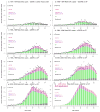The Role of Gastroesophageal Reflux and Other Factors during Progression to Esophageal Adenocarcinoma
- PMID: 25931440
- PMCID: PMC4491004
- DOI: 10.1158/1055-9965.EPI-15-0323-T
The Role of Gastroesophageal Reflux and Other Factors during Progression to Esophageal Adenocarcinoma
Abstract
Background: U.S. esophageal adenocarcinoma (EAC) incidence increased over 5-fold between 1975 and 2009. Symptomatic gastroesophageal reflux disease (sGERD) elevates the risk for EAC. However, a simple calculation suggests that changes in sGERD prevalence can explain at most approximately 16% of this trend. Importantly, a mechanistic understanding of the influence of sGERD and other factors (OF) on EAC is lacking.
Methods: A multiscale model was developed to estimate temporal trends for sGERD and OF, and their mechanistic role during carcinogenesis. Model calibration was to Surveillance, Epidemiology, and End Results (SEER) incidence and age-dependent sGERD data using maximum likelihood and Markov chain Monte Carlo (MCMC) methods.
Results: Among men, 77.8% [95% credibility interval (CI), 64.9%-85.6%] of the incidence trend is attributable to OF, 13.4% (95% CI, 11.4%-17.3%) to sGERD, and 8.8% (95% CI, 4.2%-13.7%) to sGERD-OF interactions. Among women, 32.6% (95% CI, 27.0%-39.9%) of the trend is attributable to OF, 13.6% (95% CI, 12.5%-15.9%) to sGERD, and 47.4% (95% CI, 30.7%-64.6%) to interactions. The predicted trends were compared with historical trends for obesity, smoking, and proton pump inhibitor use. Interestingly, predicted OF cohort trends correlated most highly with median body mass index (BMI) at age 50 (r = 0.988 for men; r = 0.998 for women).
Conclusions: sGERD and OF mechanistically increase premalignant cell promotion, which increases EAC risk exponentially with exposure duration.
Impact: Surveillance should target individuals with long-duration sGERD and OF exposures.
©2015 American Association for Cancer Research.
Conflict of interest statement
Conflict of interest: None.
Figures


References
-
- Kubo A, Cook MB, Shaheen NJ, Vaughan TL, Whiteman DC, Murray L, et al. Sex-specific associations between body mass index, waist circumference and the risk of Barrett’s oesophagus: a pooled analysis from the international BEACON consortium. Gut. 2013;62:1684–91. doi: 10.1136/gutjnl-2012-303753. Epub 2013/01/29. - DOI - PMC - PubMed
Publication types
MeSH terms
Supplementary concepts
Grants and funding
LinkOut - more resources
Full Text Sources
Medical
Research Materials

